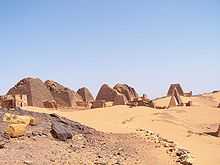Arqamani
| Arqamani | |||||
|---|---|---|---|---|---|
| Kushite King of Meroe | |||||
 Arqamani's pyramid: first one from the left. | |||||
| Reign | late 3rd to early 2nd Century BCE | ||||
| Predecessor | Arnekhamani | ||||
| Successor | Adikhalamani | ||||
| |||||
| Dynasty | Meroitic | ||||
| Born | BCE | ||||
| Died | Second Century BCE | ||||
| Burial | Pyramid at Meroë: Beg. N 7 | ||||
King Arqamani was a Kushite King of Meroë dating from the late 3rd to early 2nd century BCE who is known from inscriptions from Philae and Dakka.[1] Identified as Meroitic for Ergamenes king of Meroë or Upper Ethiopia at the time of Ptolemy II Philadelphus mentioned by Diodorus Siculus, though it is possible that several kings were fused into a single figure.[1][2][3]
Titles
- Horus name: Djeret-netjer-en-perefkai(..)ef-Setepenamunre-suab-tawy ("The God's Hand in his temple, Whose arm is raised (..) Chosen of Amun to purify the Lands")
- Prenomen: Djeretankhamun ("Living hand of Amun") with epithet Titre ("Image of Re")
- Nomen: Arqamani with epithet Ankhdjet-mery-iset.
Török mentions mortuary names. The mortuary Horus name is Kashy-netjery-kheper ("The Kushite whose coming into being is divine"). The nomen is accompanied by Ankhdjet-mery-iset (Egyptian) and Mkltk Istrk which is written in Meroitic script and whose meaning is not known.[4]
Monuments and Inscriptions
Arqamanni is known from inscriptions from Kalabsha, Philae and Dakka. He was buried in a pyramid in Meroë: Beg. N 7.[4]
Diodorus Siculus story of Ergamenes
Diodorus Siculus provides us with the Hellenistic view on the Kushite King of Meroë. It is possible that Greeks fused several rulers with similar names into a single figure named Ergamenes, however identification with Arqamani seems reasonable.[1] Kings Ptolemy II Philadelphus and Ergamenes lived in peace; moreover, Ergamenes was instructed in Greek philosophy, favored Greek art and its way of life. Ergamenes resented the tradition of ancient Egypt and the Ethiopian priests control over the King's power and preferred the absolute power of his neighbor, Philadelphus.[2]
A death of the kings, is still more extra-ordinary. The priests at Meroë have acquired great power. When they form a resolution, they send a courier to the king, with an order to him to die. They tell him that the gods (or oracles) had thus decreed, and that he would be guilty of crime if he violated an order from them. They added many other reasons, which would easily influence a simple man, aware of ancient custom, and who has no strength of the mind sufficient to resist such an unjust command. The first kings submitted to this cruel sentence. Ergamenes, who reigned at the time of the second Ptolemy, and who was instructed in the philosophy of Greece, was the first who dared to throw off this ridiculous yoke. He went with his army to the place difficult to get to, or fortress, when was formally the temple of gold of the Ethiopians, and caused all the priests to be massacred, and instituted himself a new religion.[3]
References
- ↑ 1.0 1.1 1.2 J. Desmond Clark. The Cambridge history of Africa. Cambridge University Press. pp. 228, 241. ISBN 978-0-521-21592-3. Retrieved 17 March 2011.
- ↑ 2.0 2.1 Samuel Sharpe (1859). The history of Egypt: from the earliest times till the conquest by the Arabs, A.D. 640. E. Moxon. p. 316. Retrieved 17 March 2011.
- ↑ 3.0 3.1 George Alexander Hoskins. Travels in Ethiopia, above the Second Cataract of the Nile. Exhibiting the State of that Country, and Its Various Inhabitants, under the Dominion of Mohammed Ali and Illustrating the Antiquities, Arts, and History of the Ancient Kingdom of Meroe. Elibron.com. p. 314. ISBN 978-1-4021-6047-9. Retrieved 17 March 2011.
- ↑ 4.0 4.1 László Török, The kingdom of Kush: handbook of the Napatan-Meroitic Civilization, 1997
Further reading
- Laszlo Török, in: Fontes Historiae Nubiorum, Vol. II, Bergen 1996, 660-662